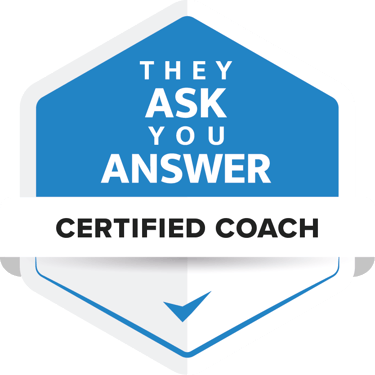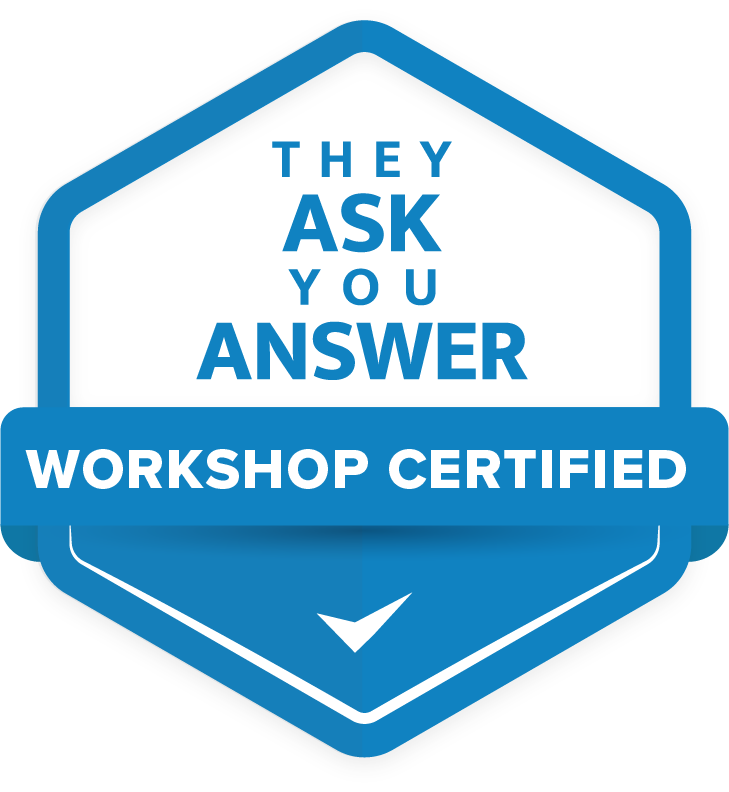What is They Ask, You Answer? [with video]

Are you not getting enough quality leads through your website?
Are you frustrated because you are investing a lot of time and money in marketing without clear results?
And don't know what to do to get the results you are looking for?
You are not alone.
Many companies struggle with the same problem, wondering how to gain their customers' trust and strengthen their market position.
Fortunately, there is a solution. And it's called: They Ask, You Answer.
At Buzzlytics, we help companies implement this proven method, and I see time and time again what this approach does for companies:
- Shorter sales cycles
- Higher quality organic leads
- Better collaboration between marketing and sales
And so on.
In this article, I explain what They Ask, You Answer is, where it comes from and its core principles. By the end, you'll know exactly how to put your customers' questions and needs first, gain their trust and become an authority in your market.
Let's take the first step together toward increased sales for your business.
What is They Ask, You Answer?
They Ask, You Answer (TAYA) is a business philosophy that revolves around an obsession with your customers' questions, needs and concerns.
By answering all their questions openly and honestly - preferably before your customers have even asked them - you will gain their trust and become the authority in your market.
Many companies have seen their sales and revenue grow because of this approach, because TAYA is in line with the way people (b2c and b2b) research and make purchasing decisions today.
They Ask, You Answer is a business philosophy that revolves around an obsession with your customers' questions, needs and concerns.
Where does TAYA come from?
TAYA was developed by American Marcus Sheridan.
His pool company was on the brink of bankruptcy in early 2009, due to the credit crisis.
In the end, Marcus decided to look into marketing. As a non-marketer, he came to the conclusion that terms like inbound marketing and content marketing amounted to answering customer questions.
So he made a list of all the questions customers had ever asked him and answered each one in a blog that he then posted on the website.
Within a few months, Marcus saw results:
- Traffic to his website increased
- The number of leads increased
- The leads were better prepared
- Swimming pools were even sold again
TAYA was born.
Core principles of TAYA
TAYA consists of ten core principles. Below I explain each one of them.
The Big 5
The Big 5 are five blog topics that create the most transactions, conversions, leads and sales:
- Prices and costs
- Problems/disadvantages
- Equations
- Reviews
- The best in its class
Marcus discovered this Big 5 when he analyzed his statistics after six months to determine which content was generating the most results.
Moreover, after later introducing the Big 5 to his marketing agency's clients, he discovered that these five topics are universal: in every industry, consumers and businesses want to know more about them before making a purchasing decision.
That's why Marcus called these five topics the 'Big 5'. They are an excellent starting point for any company that wants to get started with They Ask, You Answer.
The Big 5 are the topics that all customers in every industry consider most important before making a purchase decision.
Assignment selling
'Assignment selling' involves sending people who schedule a sales call with you some 'homework' prior to that call. For example, an e-book, a video or a couple of blogs.
Many companies find it exciting to apply assignment selling: they are eager to bring in the prospect and wonder if they are not actually driving him away by giving him extra work. After all, who has time to read a 30-page e-book these days?
But before you toss this idea aside, it's worth noting that the moment Marcus Sheridan dove into his website's data, he discovered that he was dealing with two very different groups of people requesting sales calls:
- Group 1: read a few pages and proceeded to purchase in only 25% of cases
- Group 2: read an average of 30 pages and proceeded to buy in a whopping 80% of cases
Even with our clients, we see that prospects who consume more content are more willing to buy. So it is much smarter to invest your time in the group that is willing to consume your content, rather than in the group that is unlikely to buy from you anyway.
And the great thing is: thanks to smart marketing automation platforms like HubSpot, you can see exactly who falls into group 1 and who falls into group 2.
Prospects who consume more content are more willing to buy.
In-house content management
Within TAYA, content production (written content and video content) must be done in-house.
But don't make the mistake of thinking that one of your current employees can do it on the side.
Content management is a full-time job and requires consistency. Someone who "just does it on the side" cannot deliver the consistency and quality required to successfully implement TAYA. So you need a full-time content manager.
Revenue team
At many companies, sales and marketing work alongside each other on separate islands. Marketing deals with generating leads and sales deals with closing deals.
Within companies implementing TAYA, marketing and sales work together in a revenue team, meeting weekly to celebrate successes and discuss challenges. This team has one common goal: to increase revenue.
To achieve that goal, the revenue team develops and implements a content strategy that speeds up the sales process and is based on your ideal buyers' most pressing questions.
The revenue team is essential to the success of inbound marketing and sales.
Learning centre
A corporate news blog? That doesn't fit within the TAYA philosophy. Instead, set up a learning centre that collects all your educational content.
This is where visitors to your website or customers will find the answers to their specific questions or can find information about topics they want to learn more about.
So a learning centre is different from a blog. A blog only contains articles, but in a learning centre you also find videos, podcasts, courses, guides, tools and assessments. In a learning centre, you place only educational content. So business updates do not belong there.
The information in the learning centre should be well organized so that visitors can easily find what they are looking for and continue their journey on your website in a natural and intuitive way.
The 'Selling 7'
The "Selling 7" are the visual equivalent of the Big 5. These are seven types of videos that are proven to produce results.
These are them:
- 80% videos: in them you answer 7-10 of the most frequently asked questions (together 80% of all questions you get)
- Employee bio videos: in them your employees briefly introduce themselves
- Product/service videos: in these you explain your product or service and who your offering is and is not suitable for
- Landing page videos: you put these on every page that requires someone to fill out a form
- Video on prices and costs: in it you explain how your prices are arrived at
- Customer journey videos: in these you show the successes previous customers have had with your product or service
- "Claims we make" videos: these videos show what you can do for your customers, rather than just saying it (show, don't tell)
The "Selling 7" are seven types of videos that are proven to produce results.
Virtual selling
McKinsey research shows that 75% of b2b customers prefer remote sales calls to traditional face-to-face calls.
Virtual selling jumps on this. It involves making sales calls that you normally make face-to-face or over the phone via video call.
Think of 1-to-1 video calls, which we have become completely accustomed to since COVID-19, but also think of asynchronous communication, such as videos in emails.
According to Superoffice, just the word "video" in an email subject line increases opening rates by 6%. According to Campaign Monitor, opening rates can even increase by 19%, and click rates by 65%.
Clearly, if you don't use video in your communications with customers, you are missing clicks, opportunities and damaging your sales pipeline.
Self-service tools
According to research and consulting firm Gartner, 33% of all buyers prefer a completely "seller-free" buying experience.
In other words, they want to be able to complete their purchase without having to talk to a salesperson. For millennials, this percentage is as high as 44%.
Self-service tools allow you to meet this need. These tools help visitors find answers to their questions and set up their own buying experience.
Examples of self-service tools are:
- Cost and price calculators
- Chatbots
- Tools that allow customers to schedule an appointment with you themselves
These kinds of tools are becoming increasingly important in a world where people can buy almost anything online. So you can't avoid using them.
Fortunately, thanks to AI, chatbots are getting better and better, and customized tools are often not as costly as you might expect.
Self-service tools help visitors find answers to their questions and set up their own buying experience.
Sales and marketing alignment
The concept of sales and marketing alignment is closely aligned with the concept of a revenue team. It involves sales and marketing working together as one team (i.e., a revenue team) to achieve common goals, such as revenue growth, lead generation and shorter sales cycles.
Here's how it works in a nutshell: sales gives marketing input for content, and marketing then creates content that helps sales accelerate the sales process.
Implementation of martech and CRM
Finally, if you invest the time, resources and money to make inbound marketing and creation work, you should also invest in the right tools.
Only with seamlessly integrated marketing automation and CRM platforms like HubSpot can you:
- Provide your sales team with the insights they need about prospects and the content they consume so they can have more effective sales conversations
- track the ROI of your inbound marketing efforts and understand exactly how your content is or is not being used to close deals and generate sales
Are you ready to take your business to the next level?
They Ask, You Answer can help your business achieve better results. It is a powerful business philosophy that revolves around answering your customers' questions, concerns and needs. By doing this in an open and honest way, you win their trust and become the authority in your market.
At Buzzlytics, we help companies implement the They Ask, You Answer method in our TAYA Mastery program. We believe this is the future of marketing and sales, and we see companies that embrace this approach achieve better results.
After reading this article, did you get excited about They Ask, You Answer and want to discover how this method can help your business? Then schedule an appointment with one of our certified They Ask, You Answer consultants.
Related articles
July 4, 2024
-
Reading time: +/- 9 min
October 3, 2024
-
Reading time: +/- 7 min








